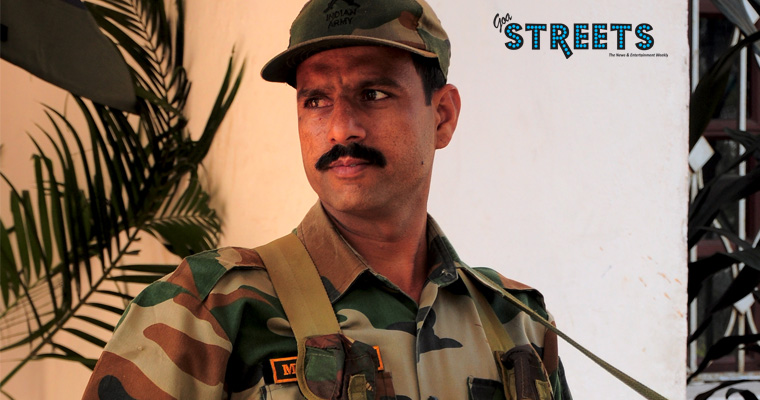They were taking heavy fire from close range. But the assault team of the Indian army’s 27 Rajput regiment led by major Amit Parab lay low, ed waiting for their chance. They knew it would come.
Crouched within the stone-lined house in Kashmir’s violence-ridden Pulwama district was Shabir Ahmed, a dreaded battalion commander of the terror outfit Hizbul Mujahideen and eight other armed militants, who were spraying sporadic fire at the soldiers. In a carefully chosen moment, the army men made their move.
Shabir and his men never made it out of the house. The ‘Sena medal’ citation earned by Parab, who hails from Bicholim, credits the officer for his “gallantry, for his exemplary courage, dare devilry, audacity, sheer grit, perseverance under heavy fire from close range, sharp presence of mind and admirable leadership qualities.” Parab’s exploits are rare in a state whose youngsters these days often choose to stay away from a career in the armed forces.
“There are very few Goans in the army, even fewer below the rank of officer,” says Brigadier K S Chauhan, a recently retired commandant of the 2 Signals Training Centre in Panjim. Perhaps chief among the reasons so few Goans join the army is a relatively high standard of living that gives young folks the liberty to opt out, as compared to other states. Also contributing to the phenomenon are a laid-back lifestyle that’s not exactly in sync with a military regimen, a propensity among the young to migrate abroad and the former Portuguese colony’s relatively recent induction into the Indian union (Portugal didn’t emulate the British tradition of recruiting Indians into the army).
For his part, Chauhan blames negative publicity as the reason why few Goans are queuing up to join. “If the chief minister of a state makes a statement in the assembly that it is easier to get the Pakistan army out of Lahore than the Indian army out of Panjim, what impression will that make. That is a very derogatory remark. It gives the impression that we are occupiers,” he says, citing a speech last July by Manohar Parrikar.

The chief minister was trying to make the point that Goans should have more say in what happens to real estate occupied by the military after it liberated Goa from Portuguese rule in 1961. He lamented that armed forces have refused to budge in three decades of negotiations, even after being offered alternative land.
Chauhan, however, wonders why the military should be asked to take a back seat to other interests. In the easygoing land of “sussegado”, joining the army is certainly not an automatic career choice. It’s quite unlike the case in Punjab, Haryana, Darjeeling and other places where unemployment, family military traditions, as well as low private sector wages see a lot of youngsters signing up for the olive green uniform.

John Aguiar is the company commander of the Goa home guards, a civilian defence force. One of his chores is to inspire youngsters to love the uniform. John says he hasn’t cut much ice with his argument.
“The number is small. Young Goan boys prefer to be in Goa and don’t want to go out. They will prefer to go Saudi Arabia or other Gulf countries (for employment), but not the army,” John told Streets, adding that the aggressively strict demands of an army stint did not seem like their cup of tea.
Lieutenant commander John Gomes points out that the slack interest in the army is a nationwide phenomenon, only in Goa it’s worse. “This is not just a Goan phenomenon. It’s everywhere. Chaps who do not have work are the ones who join the armed forces. Moreover, the army is treated like shit by the government,” the naval commander said. Scandals tumbling out of the army’s closet and failure of the forces to re-package themselves to newer generations have made the career option unattractive.
But of course there are exceptions like major Pascoal D’Souza from Calangute, who’s presently posted in Punjab. A stint in the National Cadet Corps, a military cadet wing of the Indian army and goading by late Lieutenant Colonel Sylvester D’Souza from Sangolda helped him get through the examinations required to join the army as an officer.
There is hope, according to Major Venugopalan Nair, secretary of the Sainik (soldier) Welfare Board, which acts as a liaison between serving and retired armed forces personnel and the local administration. “I think the situation has drastically improved over time. Of late there has been a lot of interest as well as awareness,” Nair says, adding that a slowdown in the mining sector and a threat of job cuts could nudge Goan youth towards the army. “In the last recruitment camp the army held (in Goa), more than 23 Goans joined in. The Navy and IAF (Indian Air force) too had had good response to their drives, though I won’t be able to give you exact figures,” Nair informed.
Various military units hold these camps in Goa and other Western states every year, and 23 enrolled Goans was the best showing in years. Even so, it’s a singularly small number amongst the thousands of hopefuls who attend the camps from around Western India. Unfortunately, no authoritative figures are available on the number of Goans currently in the military.
What also has potential to fuel the army-recruitment queues in Goa is a recently floated state government scheme incentivising recruitment by offering a cash award of Rs 1 lakh.
Not that the drought of Goans in the army has been around forever. In the past, several Goans have served the upper echelons of the Indian military, like General Sunith Rodrigues, Vice Admiral John D’Silva, Air Chief Marshal Hrishikesh Moolgavkar, among several other uniformed luminaries.
“The number of Goans in independent India’s defence services is a matter of pride,” according to Valmiki Faleiro, who recently authored a book ‘Goans in India’s defence service.’ Faleiro says that in the past a spirit of adventure lured a lot of Goans to join the armed forces, but adds that today awareness levels about what the army can really offer are poor. “Few know commissioned officers start on a salary of Rs.35,000 (per) month, forget the myriad perks. Motivated kids are discouraged by parents – who are oblivious of the fact that life is riskier on Goa’s roads than in the forces,” the author says.
I asked seven-year-old Raegen Cruz from Anjuna if he would consider a career in the armed forces when he grows up. For a brief moment, he disengaged himself from the ‘Age of Empires 3’ game he was playing on is computer and gave me this reply: “I want to be Sachin Tendulkar when I grow up.” As he slipped back into his war strategy game, Raegan also told me that his kingdom had just trounced three rival armies in less than two hours of game time.
.
..





